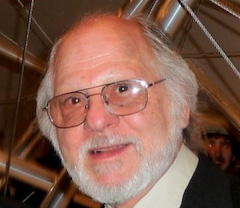
Welcome to Biotensegrity.com

Stephen M Levin MD
Tensegrity icosahedrons are used to model biologic organisms from viruses to vertebrates, their cells, systems and subsystems.
I regard the term “tensegrity” as conceived by R. Buckminster Fuller, who coined the term, and Kenneth Snelson, who first applied the mechanical principles to modern structures as an art form,
I have moved to the term 'biotensegrity' to consider tensegrity as a force vector concept as applied to biology.
There are only tension and compression elements in tensegrity systems. There are no shears, bending moments or levers, just simple tension and compression, in a self organizing, hierarchical, load distributing, low energy consuming structure.
After you have read some of the papers in the papers section, you might want to read more about Tensegrity. For an excellent review by an architect see Val Jauregui's architectual thesis found here.
For furthur understanding of tensegrity in biologic structures from the viewpoint of a geometer/artist/inventor see Tom Flemons' The Geometry of Anatomy and The Bones of Tensegrity published on his website. Tom makes models of anatomical structures based on biotensegrity principles. Most of the models I show in my DVD are made by Tom and a third of the DVD is a discussion I have with him about Biotensegrity using his models to illustrate the concept.
Michael Turvey has written an extensive analysis in which the whole topic of musculoskeletal synergies is explored (41 pages). Needless for me to say, the concept of biotensegrity is included in the discussion. Turvey MT. 2007. Action and perception at the level of synergies. Hum Mov Sci. 26 (2007) 657-697
J.C Guimberteau has produced a remarkable DVD, Strolling Under the Skin, that demonstrates tensegrity in action in the fascia. A 'must see'.
You might also want to investigate Donald Ingber's on-going research here. He is the other guy working on this stuff, but primarily at the cellular level. We have some differences on points, most notably as discussed on my Blog under 'Shear or no Shear', but that is minor compared to what we do agree on.
I regard the term “tensegrity” as conceived by R. Buckminster Fuller, who coined the term, and Kenneth Snelson, who first applied the mechanical principles to modern structures as an art form,
I have moved to the term 'biotensegrity' to consider tensegrity as a force vector concept as applied to biology.
There are only tension and compression elements in tensegrity systems. There are no shears, bending moments or levers, just simple tension and compression, in a self organizing, hierarchical, load distributing, low energy consuming structure.
After you have read some of the papers in the papers section, you might want to read more about Tensegrity. For an excellent review by an architect see Val Jauregui's architectual thesis found here.
For furthur understanding of tensegrity in biologic structures from the viewpoint of a geometer/artist/inventor see Tom Flemons' The Geometry of Anatomy and The Bones of Tensegrity published on his website. Tom makes models of anatomical structures based on biotensegrity principles. Most of the models I show in my DVD are made by Tom and a third of the DVD is a discussion I have with him about Biotensegrity using his models to illustrate the concept.
Michael Turvey has written an extensive analysis in which the whole topic of musculoskeletal synergies is explored (41 pages). Needless for me to say, the concept of biotensegrity is included in the discussion. Turvey MT. 2007. Action and perception at the level of synergies. Hum Mov Sci. 26 (2007) 657-697
J.C Guimberteau has produced a remarkable DVD, Strolling Under the Skin, that demonstrates tensegrity in action in the fascia. A 'must see'.
You might also want to investigate Donald Ingber's on-going research here. He is the other guy working on this stuff, but primarily at the cellular level. We have some differences on points, most notably as discussed on my Blog under 'Shear or no Shear', but that is minor compared to what we do agree on.